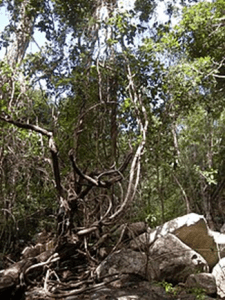TAG: GS 3: ECOLOGY AND ENVIRONMENT
THE CONTEXT: Lianas, woody vining plants that thrive in disturbed forest areas, have emerged as an unexpected menace to Earth’s carbon sinks.
EXPLANATION:
- Their competitive nature for sunlight in the forest canopy suppresses trees, which are major carbon sinks, thereby diminishing the forest’s capacity to sequester carbon.
- The implications of liana dominance for global warming and carbon cycles has been emphasizes.
Factors Driving Liana Dominance Over Trees
- Lianas exhibit higher competitive success over trees in disturbed forest areas, such as those affected by logging or natural treefalls.
- Forests recovering from disturbances lack structural support for tree growth, favoring liana proliferation.
- Warmer temperatures, lower precipitation, and tropical lowlands provide favorable conditions for lianas.
- They are more resilient to climatic stress and can efficiently utilize water and nutrients, giving them a competitive advantage over trees.
- Topography influences sunlight availability and soil moisture levels, further favoring lianas.
Impacts of Liana Dominance on Forest Ecosystems
- Liana proliferation can lead to decreased tree regeneration, growth, and survival, altering forest structure and ecosystem function.
- This affects the subsequent recovery of forests following disturbances.
- Lianas alter nutrient cycling within forests, decreasing overall ecosystem resilience to environmental changes and making ecosystems more susceptible to further disturbances.
Implications for Carbon Sequestration and Global Warming
- Lianas store less carbon than trees, and their dominance diminishes the forest’s capacity to sequester carbon.
- Slower forest recovery following disturbance, due to liana competition, means less carbon being sequestered by the forest.
- The reduction in the effectiveness of forests as carbon sinks exacerbates global warming, altering global carbon cycles.
- Slower forest recovery contributes to increased atmospheric carbon dioxide levels.
Balancing Lianas and Trees for Ecosystem Health
- The goal should not be to eliminate lianas from forests but to maintain a balance between lianas and trees that allows for both forest recovery and biodiversity conservation.
- Forest managers and conservation agencies can use these findings to prioritize restoration efforts, particularly in regions vulnerable to liana dominance like the Amazon, the Congo Basin, and the Borneo-Mekong Forest Basin.
Liana:
- A liana is a long-stemmed, woody vine that is rooted in the soil at ground level and uses trees, as well as other means of vertical support, to climb up to the canopy in search of direct sunlight.
- The word liana does not refer to a taxonomic grouping, but rather a habit of plant growth – much like tree or shrub.
- It comes from standard French liane, itself from an Antilles French dialect word meaning to sheave.

SOURCE: https://www.downtoearth.org.in/interviews/forests/-lianas-threaten-earth-s-carbon-sinks–95139
Spread the Word
